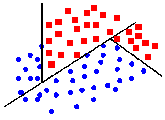Pattern Separation via Mathematical Programming

This WWW page describes work in Pattern Separation via Linear Programming in
the Mathematical Programming section of the
University of Wisconsin-Madison Computer Sciences Department.
Brief History and Method Outline
Mathematical optimization approaches, in particular linear programming, have
long been used in problems of pattern separation.
In [65] linear programs were used to construct planes
to separate linearly separable point sets.
Separation by a nonlinear surface
using linear programming was also described, whenever the surface
parameters appeared linearly,
e.g. a quadratic or polynomial surface. These formulations however could fail
on sets that were not separable by a surface linear in its parameters.
A Multisurface Method (MSM) [68,93]
avoided this difficulty. MSM separates 2 disjoint finite point sets in
n-dimensional Euclidean space as follows:
- Choose 2 parallel planes in n-dimensional Euclidean space
as close together so that only the region between the two planes
contains points from both sets (i.e. the regions NOT between the
2 parallel planes contain only points of 1 set or no points).
- Discard the points in the regions not between the 2 parallel planes.
- Repeat the process on the points between the 2 parallel planes, until
the region between the 2 parallel planes contains no points or very
few points.
Multisurface Method Tree (MSM-T),
a variant on the Multisurface Method was developed in
[92a], [92b], [93].
Let A and B be finite disjoint point sets in n-dimensional Euclidean
space.
The goal of MSM-T is to
determine a sequence of planes in n-dimensional Euclidean
space that separate the sets A and B as follows:
- Determine a plane in n-dimensional Euclidean space that
minimizes the average "distances" of misclassified points. A point from
set A is misclassified if it lies on the side of the separating
plane assigned to B.
Similarly, a point from set B is misclassified if it lies
on the side of the separating plane assigned to A.
- If the regions assigned to A and B contain only (or
mostly) points of the set A or B, then stop.
Otherwise, generate another
error-minimizing plane (in 1.) in this region.
The sequence of planes generated can be viewed as a decision tree. For each
node in the tree, the best split of the points reaching that node is found
by solving the LP in 1, above. The node is split into 2 branches, and the
same procedure is applied until there are only (or mostly) points of one
set at the node. This linear programming approach can also be viewed as
training a neural network with 1 hidden layer
(see [93]).
MSM-T has been shown to learn concepts as well or better than more traditional
learning methods such as C4.5 and CART. It also has an advantage over
artificial neural network (ANN) methods such as backpropagation in
that training proceeds much faster (see [92a]).
Implementations of MSM-T
MSM-T has been implemented in C using the MINOS numerical
optimization package by Nick Street and Kristin Bennett. MSM-T has also been implemented
for the MATLAB
optimization package by Paul Bradley. Following is a description of the MATLAB implementation of MSM-T. Together with the M-files
required to run it.
Chronological Bibliography
- [65] O. L. Mangasarian.
- Linear and Nonlinear Separation of Patterns by Linear Programming.
Operations Research, Vol. 13, No. 3, May-June, 1965, pages
444 - 452.
- [68] O. L. Mangasarian.
- Multisurface Method of Pattern Separation. IEEE
Transactions on
Information Theory, Vol. IT-14, No. 6, November 1968, pages
801 - 807.
- [92a] K. P. Bennett.
- Decision Tree Construction via Linear Programming. Proceedings of the 4th Midwest Artificial Intelligence and Cognitive Science Society Conference, 1992, pages 97 - 101.
- [92b] K. P. Bennett and O. L. Mangasarian.
- Robust Linear Programming Discrimination of Two Linearly Inseparable Sets. Optimization Methods and Software, Vol. 1, 1992, pages 23 - 34.
- [93] O. L. Mangasarian.
- Mathematical Programming in Neural Networks. ORSA Journal on Computing, Vol. 5, No. 4, Fall 1993, pages 349 - 360.
Last modified: Wed Jul 12 10:40:37 1995 by Paul Bradley
paulb@cs.wisc.edu
